2014 NISSAN GT-R steering
[x] Cancel search: steeringPage 275 of 354
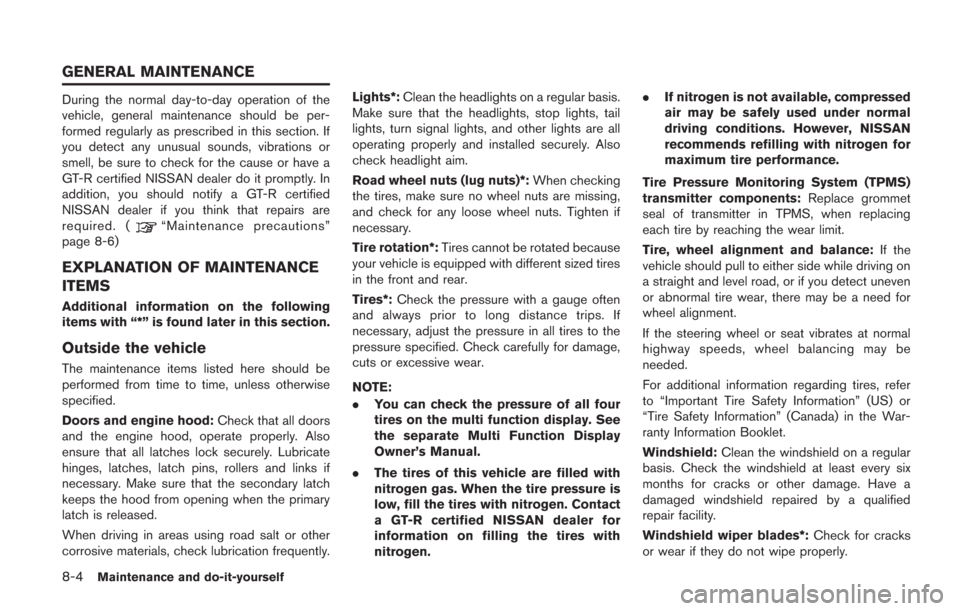
8-4Maintenance and do-it-yourself
During the normal day-to-day operation of the
vehicle, general maintenance should be per-
formed regularly as prescribed in this section. If
you detect any unusual sounds, vibrations or
smell, be sure to check for the cause or have a
GT-R certified NISSAN dealer do it promptly. In
addition, you should notify a GT-R certified
NISSAN dealer if you think that repairs are
required. (
“Maintenance precautions”
page 8-6)
EXPLANATION OF MAINTENANCE
ITEMS
Additional information on the following
items with “*” is found later in this section.
Outside the vehicle
The maintenance items listed here should be
performed from time to time, unless otherwise
specified.
Doors and engine hood: Check that all doors
and the engine hood, operate properly. Also
ensure that all latches lock securely. Lubricate
hinges, latches, latch pins, rollers and links if
necessary. Make sure that the secondary latch
keeps the hood from opening when the primary
latch is released.
When driving in areas using road salt or other
corrosive materials, check lubrication frequently. Lights*:
Clean the headlights on a regular basis.
Make sure that the headlights, stop lights, tail
lights, turn signal lights, and other lights are all
operating properly and installed securely. Also
check headlight aim.
Road wheel nuts (lug nuts)*: When checking
the tires, make sure no wheel nuts are missing,
and check for any loose wheel nuts. Tighten if
necessary.
Tire rotation*: Tires cannot be rotated because
your vehicle is equipped with different sized tires
in the front and rear.
Tires*: Check the pressure with a gauge often
and always prior to long distance trips. If
necessary, adjust the pressure in all tires to the
pressure specified. Check carefully for damage,
cuts or excessive wear.
NOTE:
. You can check the pressure of all four
tires on the multi function display. See
the separate Multi Function Display
Owner’s Manual.
. The tires of this vehicle are filled with
nitrogen gas. When the tire pressure is
low, fill the tires with nitrogen. Contact
a GT-R certified NISSAN dealer for
information on filling the tires with
nitrogen. .
If nitrogen is not available, compressed
air may be safely used under normal
driving conditions. However, NISSAN
recommends refilling with nitrogen for
maximum tire performance.
Tire Pressure Monitoring System (TPMS)
transmitter components: Replace grommet
seal of transmitter in TPMS, when replacing
each tire by reaching the wear limit.
Tire, wheel alignment and balance: If the
vehicle should pull to either side while driving on
a straight and level road, or if you detect uneven
or abnormal tire wear, there may be a need for
wheel alignment.
If the steering wheel or seat vibrates at normal
highway speeds, wheel balancing may be
needed.
For additional information regarding tires, refer
to “Important Tire Safety Information” (US) or
“Tire Safety Information” (Canada) in the War-
ranty Information Booklet.
Windshield: Clean the windshield on a regular
basis. Check the windshield at least every six
months for cracks or other damage. Have a
damaged windshield repaired by a qualified
repair facility.
Windshield wiper blades*: Check for cracks
or wear if they do not wipe properly.
GENERAL MAINTENANCE
Page 276 of 354

Inside the vehicle
The maintenance items listed here should be
checked on a regular basis, such as when
performing scheduled maintenance, cleaning
the vehicle, etc.
Accelerator pedal:Check the pedal for
smooth operation and make sure the pedal
does not catch or require uneven effort. Keep
the floor mat away from the pedal.
Transmission
&Pmechanism: On a fairly
steep hill, check that your vehicle is held
securely with the shift lever in the
&Pposition
without applying any brakes.
Brake pedal: Check the pedal for smooth
operation. If the brake pedal suddenly goes
down further than normal, the pedal feels
spongy or the vehicle seems to take longer to
stop, see a GT-R certified NISSAN dealer
immediately. Keep the floor mat away from the
pedal.
Brakes: Check that the brakes do not pull the
vehicle to one side when applied.
Parking brake: Check the parking brake
operation regularly. The vehicle should be
securely held on a fairly steep hill with only the
parking brake applied. If the parking brake needs
to be adjusted, see a GT-R certified NISSAN
dealer. Seat belts:
Check that all parts of the seat belt
system (for example, buckles, anchors, adjuster
and retractors) operate properly and smoothly,
and are installed securely. Check the belt
webbing for cuts, fraying, wear or damage.
Seats: Check seat position controls such as
seat adjusters, seatback recliner, etc. to ensure
they operate smoothly and that all latches lock
securely in every position.
Steering wheel: Check for changes in the
steering conditions, such as excessive free play,
hard steering or strange noises.
Warning lights and chimes: Make sure that
all warning lights and chimes are operating
properly.
Windshield defroster: Check that the air
comes out of the defroster outlets properly and
in sufficient quantity when operating the heater
or air conditioner.
Windshield wiper and washer*: Check that
the wipers and washer operate properly and that
the wipers do not streak.
Under the hood and vehicle
The maintenance items listed here should be
checked periodically (for example, each time you
check the engine oil or refuel) . Battery*:
Check the fluid level in each cell. It
should be between the MAX and MIN lines.
Vehicles operated in high temperatures or under
severe condition require frequent checks of the
battery fluid level.
Brake fluid level*: Make sure that the brake
fluid level is between the MAX and MIN lines on
the reservoir.
Engine coolant level*: Check the coolant level
when the engine is cold.
Engine drive belts*: Make sure that no belt is
frayed, worn, cracked or oily.
Engine oil level*: Check the level after parking
the vehicle on a level spot and turning off the
engine. Wait at least 5 minutes for the oil to
drain back into the oil pan before checking the
oil.
Exhaust system: Make sure there are no loose
supports, cracks or holes. If the sound of the
exhaust seems unusual or there is a smell of
exhaust fumes in the engine compartment,
immediately have the exhaust system inspected
by a GT-R certified NISSAN dealer.
(“Exhaust gas (carbon monoxide)” page
5-3)
Fluid leaks: Check under the vehicle for fuel,
oil, water or other fluid leaks after the vehicle has
been parked for a while. Water dripping from the
Maintenance and do-it-yourself8-5
Page 277 of 354
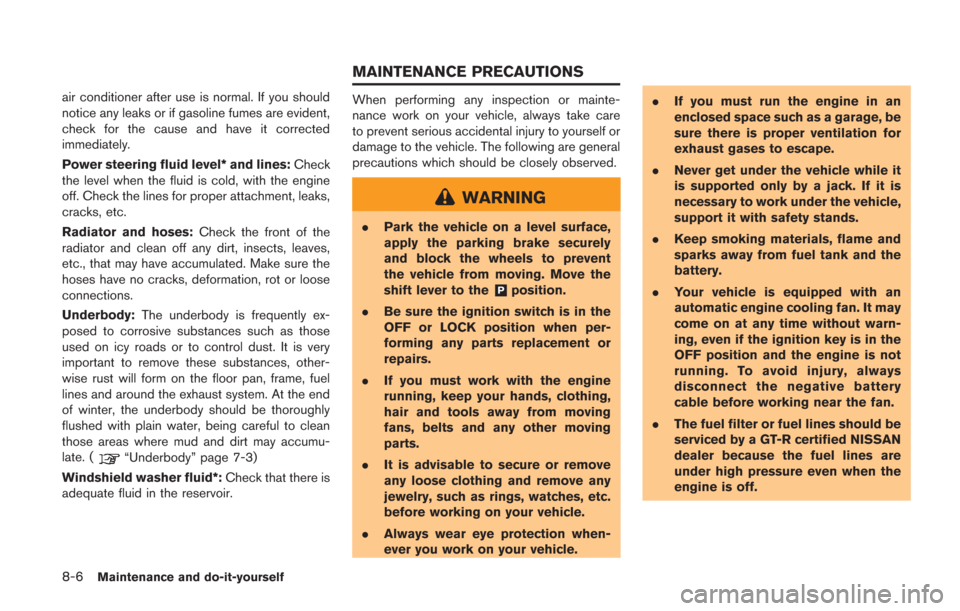
8-6Maintenance and do-it-yourself
air conditioner after use is normal. If you should
notice any leaks or if gasoline fumes are evident,
check for the cause and have it corrected
immediately.
Power steering fluid level* and lines:Check
the level when the fluid is cold, with the engine
off. Check the lines for proper attachment, leaks,
cracks, etc.
Radiator and hoses: Check the front of the
radiator and clean off any dirt, insects, leaves,
etc., that may have accumulated. Make sure the
hoses have no cracks, deformation, rot or loose
connections.
Underbody: The underbody is frequently ex-
posed to corrosive substances such as those
used on icy roads or to control dust. It is very
important to remove these substances, other-
wise rust will form on the floor pan, frame, fuel
lines and around the exhaust system. At the end
of winter, the underbody should be thoroughly
flushed with plain water, being careful to clean
those areas where mud and dirt may accumu-
late. (
“Underbody” page 7-3)
Windshield washer fluid*: Check that there is
adequate fluid in the reservoir.
When performing any inspection or mainte-
nance work on your vehicle, always take care
to prevent serious accidental injury to yourself or
damage to the vehicle. The following are general
precautions which should be closely observed.
WARNING
. Park the vehicle on a level surface,
apply the parking brake securely
and block the wheels to prevent
the vehicle from moving. Move the
shift lever to the
&Pposition.
. Be sure the ignition switch is in the
OFF or LOCK position when per-
forming any parts replacement or
repairs.
. If you must work with the engine
running, keep your hands, clothing,
hair and tools away from moving
fans, belts and any other moving
parts.
. It is advisable to secure or remove
any loose clothing and remove any
jewelry, such as rings, watches, etc.
before working on your vehicle.
. Always wear eye protection when-
ever you work on your vehicle. .
If you must run the engine in an
enclosed space such as a garage, be
sure there is proper ventilation for
exhaust gases to escape.
. Never get under the vehicle while it
is supported only by a jack. If it is
necessary to work under the vehicle,
support it with safety stands.
. Keep smoking materials, flame and
sparks away from fuel tank and the
battery.
. Your vehicle is equipped with an
automatic engine cooling fan. It may
come on at any time without warn-
ing, even if the ignition key is in the
OFF position and the engine is not
running. To avoid injury, always
disconnect the negative battery
cable before working near the fan.
. The fuel filter or fuel lines should be
serviced by a GT-R certified NISSAN
dealer because the fuel lines are
under high pressure even when the
engine is off.
MAINTENANCE PRECAUTIONS
Page 279 of 354
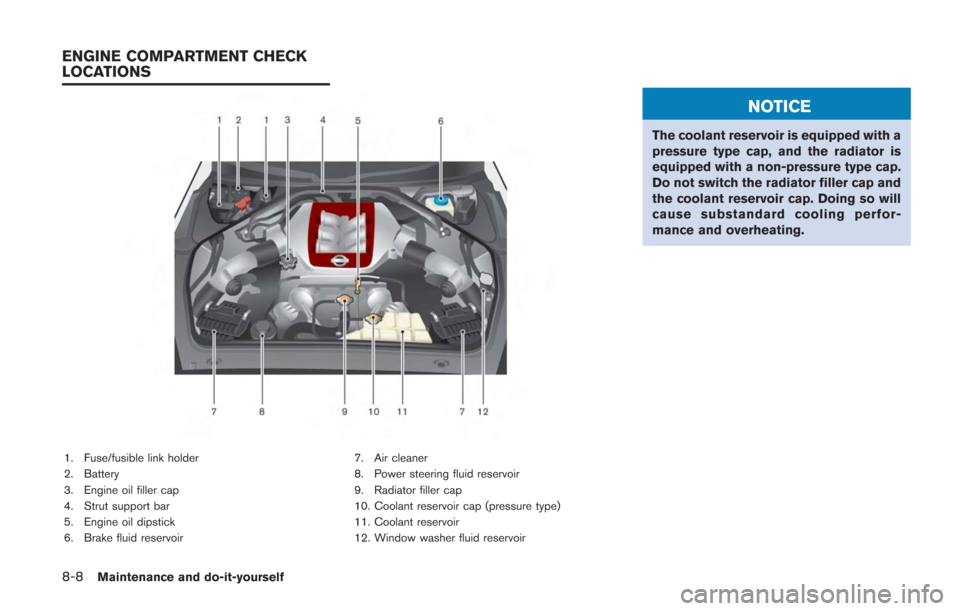
8-8Maintenance and do-it-yourself
1. Fuse/fusible link holder
2. Battery
3. Engine oil filler cap
4. Strut support bar
5. Engine oil dipstick
6. Brake fluid reservoir7. Air cleaner
8. Power steering fluid reservoir
9. Radiator filler cap
10. Coolant reservoir cap (pressure type)
11. Coolant reservoir
12. Window washer fluid reservoir
NOTICE
The coolant reservoir is equipped with a
pressure type cap, and the radiator is
equipped with a non-pressure type cap.
Do not switch the radiator filler cap and
the coolant reservoir cap. Doing so will
cause substandard cooling perfor-
mance and overheating.
ENGINE COMPARTMENT CHECK
LOCATIONS
Page 285 of 354
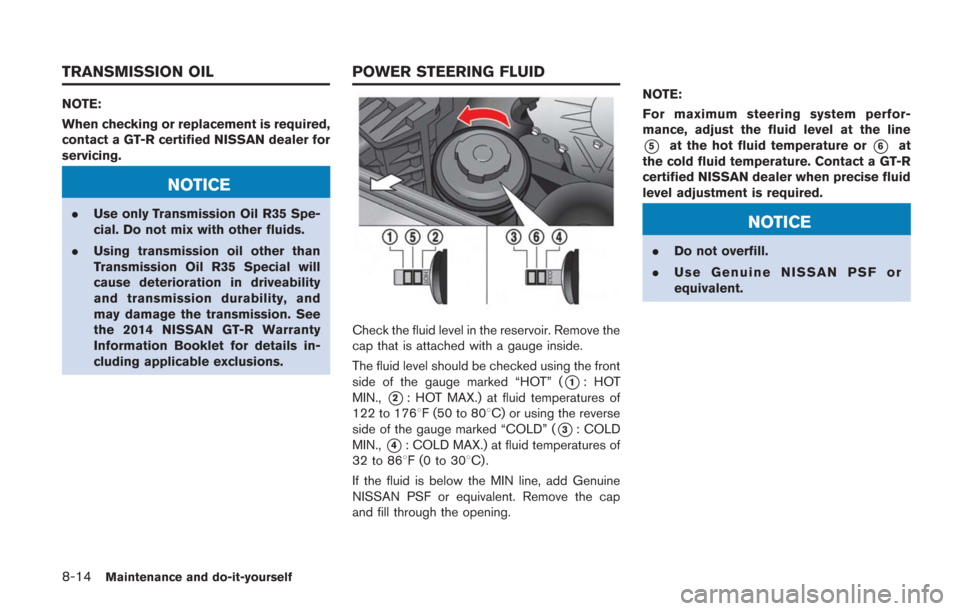
8-14Maintenance and do-it-yourself
NOTE:
When checking or replacement is required,
contact a GT-R certified NISSAN dealer for
servicing.
NOTICE
.Use only Transmission Oil R35 Spe-
cial. Do not mix with other fluids.
. Using transmission oil other than
Transmission Oil R35 Special will
cause deterioration in driveability
and transmission durability, and
may damage the transmission. See
the 2014 NISSAN GT-R Warranty
Information Booklet for details in-
cluding applicable exclusions.
Check the fluid level in the reservoir. Remove the
cap that is attached with a gauge inside.
The fluid level should be checked using the front
side of the gauge marked “HOT” (
*1:HOT
MIN.,
*2: HOT MAX.) at fluid temperatures of
122 to 1768F (50 to 808C) or using the reverse
side of the gauge marked “COLD” (
*3: COLD
MIN.,
*4: COLD MAX.) at fluid temperatures of
32 to 868F(0to30 8C) .
If the fluid is below the MIN line, add Genuine
NISSAN PSF or equivalent. Remove the cap
and fill through the opening. NOTE:
For maximum steering system perfor-
mance, adjust the fluid level at the line
*5at the hot fluid temperature or*6at
the cold fluid temperature. Contact a GT-R
certified NISSAN dealer when precise fluid
level adjustment is required.
NOTICE
. Do not overfill.
. Use Genuine NISSAN PSF or
equivalent.
TRANSMISSION OIL POWER STEERING FLUID
Page 290 of 354
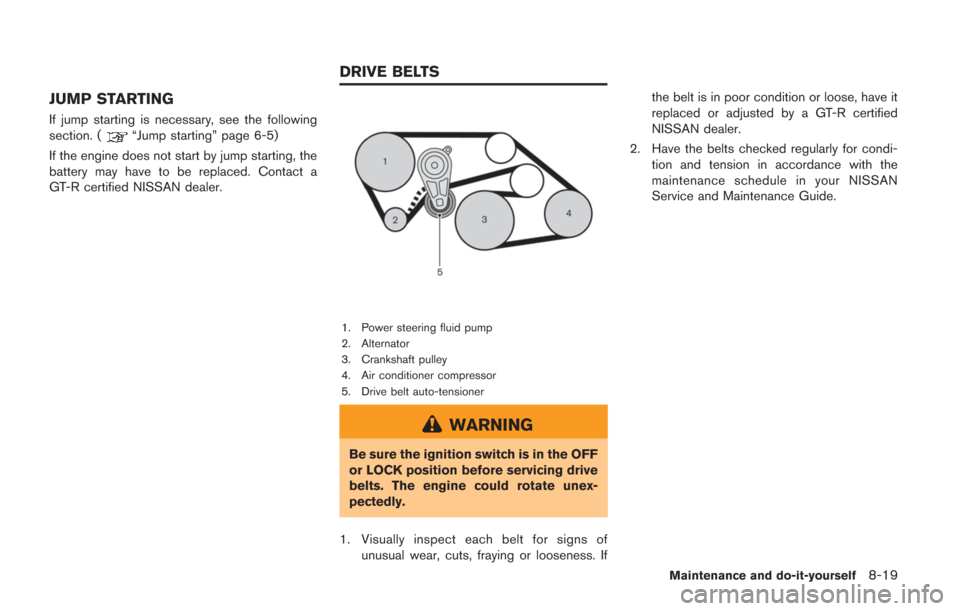
JUMP STARTING
If jump starting is necessary, see the following
section. (“Jump starting” page 6-5)
If the engine does not start by jump starting, the
battery may have to be replaced. Contact a
GT-R certified NISSAN dealer.
1. Power steering fluid pump
2. Alternator
3. Crankshaft pulley
4. Air conditioner compressor
5. Drive belt auto-tensioner
WARNING
Be sure the ignition switch is in the OFF
or LOCK position before servicing drive
belts. The engine could rotate unex-
pectedly.
1. Visually inspect each belt for signs of unusual wear, cuts, fraying or looseness. If the belt is in poor condition or loose, have it
replaced or adjusted by a GT-R certified
NISSAN dealer.
2. Have the belts checked regularly for condi- tion and tension in accordance with the
maintenance schedule in your NISSAN
Service and Maintenance Guide.
Maintenance and do-it-yourself8-19
DRIVE BELTS
Page 321 of 354
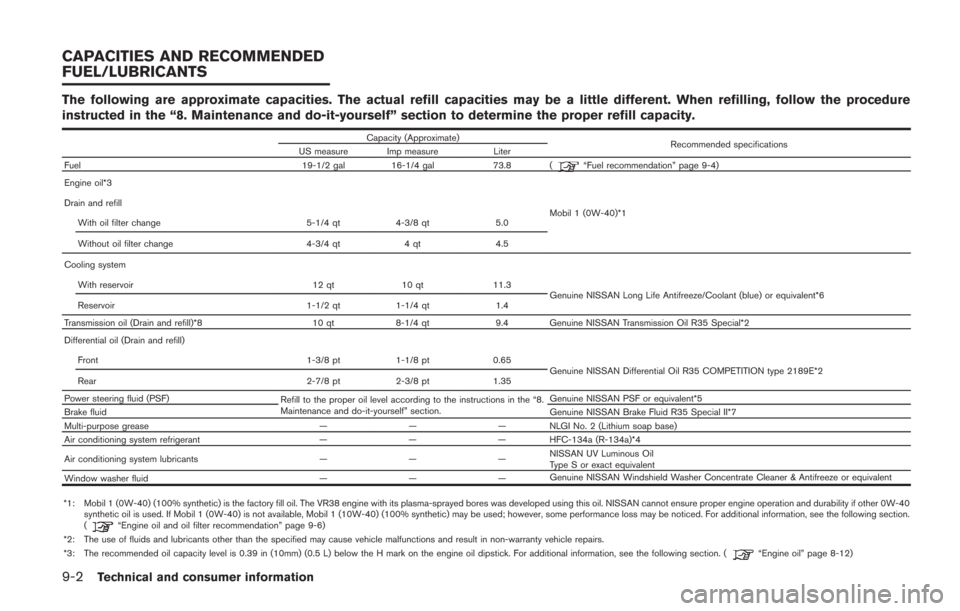
9-2Technical and consumer information
The following are approximate capacities. The actual refill capacities may be a little different. When refilling, follow the procedure
instructed in the “8. Maintenance and do-it-yourself” section to determine the proper refill capacity.
Capacity (Approximate)Recommended specifications
US measure Imp measure Liter
Fuel 19-1/2 gal 16-1/4 gal73.8 (
“Fuel recommendation” page 9-4)
Engine oil*3
Mobil 1 (0W-40)*1
Drain and refill
With oil filter change 5-1/4 qt4-3/8 qt 5.0
Without oil filter change 4-3/4 qt4 qt4.5
Cooling system With reservoir 12 qt10 qt 11.3
Genuine NISSAN Long Life Antifreeze/Coolant (blue) or equivalent*6
Reservoir 1-1/2 qt1-1/4 qt 1.4
Transmission oil (Drain and refill)*8 10 qt8-1/4 qt 9.4 Genuine NISSAN Transmission Oil R35 Special*2
Differential oil (Drain and refill)
Front 1-3/8 pt1-1/8 pt 0.65
Genuine NISSAN Differential Oil R35 COMPETITION type 2189E*2
Rear 2-7/8 pt2-3/8 pt 1.35
Power steering fluid (PSF) Refill to the proper oil level according to the instructions in the “8.
Maintenance and do-it-yourself” section. Genuine NISSAN PSF or equivalent*5
Brake fluid Genuine NISSAN Brake Fluid R35 Special II*7
Multi-purpose grease —— — NLGI No. 2 (Lithium soap base)
Air conditioning system refrigerant —— — HFC-134a (R-134a)*4
Air conditioning system lubricants —— —NISSAN UV Luminous Oil
Type S or exact equivalent
Window washer fluid —— —Genuine NISSAN Windshield Washer Concentrate Cleaner & Antifreeze or equivalent
*1: Mobil 1 (0W-40) (100% synthetic) is the factory fill oil. The VR38 engine with its plasma-sprayed bores was developed using this oil. NISSAN cannot ensure proper engine operation and durability if other 0W-40 synthetic oil is used. If Mobil 1 (0W-40) is not available, Mobil 1 (10W-40) (100% synthetic) may be used; however, some performance loss may be noticed. For additional information, see the following section.
(
“Engine oil and oil filter recommendation” page 9-6)
*2: The use of fluids and lubricants other than the specified may cause vehicle malfunctions and result in non-warranty vehicle repairs.
*3: The recommended oil capacity level is 0.39 in (10mm) (0.5 L) below the H mark on the engine oil dipstick. For additional information, see the following section. (
“Engine oil” page 8-12)
CAPACITIES AND RECOMMENDED
FUEL/LUBRICANTS
Page 345 of 354
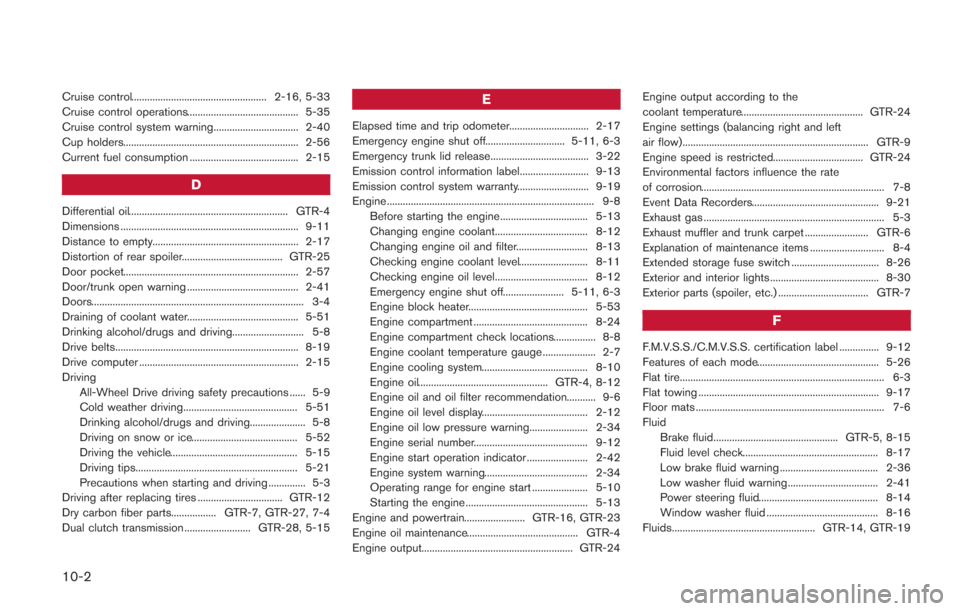
10-2
Cruise control................................................... 2-16, 5-33
Cruise control operations.......................................... 5-35
Cruise control system warning................................ 2-40
Cup holders.................................................................. 2-56
Current fuel consumption ......................................... 2-15
D
Differential oil............................................................ GTR-4
Dimensions ................................................................... 9-11
Distance to empty....................................................... 2-17
Distortion of rear spoiler...................................... GTR-25
Door pocket.................................................................. 2-57
Door/trunk open warning .......................................... 2-41
Doors................................................................................ 3-4
Draining of coolant water.......................................... 5-51
Drinking alcohol/drugs and driving........................... 5-8
Drive belts..................................................................... 8-19
Drive computer ............................................................ 2-15
DrivingAll-Wheel Drive driving safety precautions ...... 5-9
Cold weather driving........................................... 5-51
Drinking alcohol/drugs and driving..................... 5-8
Driving on snow or ice........................................ 5-52
Driving the vehicle................................................ 5-15
Driving tips............................................................. 5-21
Precautions when starting and driving .............. 5-3
Driving after replacing tires ................................ GTR-12
Dry carbon fiber parts................. GTR-7, GTR-27, 7-4
Dual clutch transmission ......................... GTR-28, 5-15
E
Elapsed time and trip odometer.............................. 2-17
Emergency engine shut off.............................. 5-11, 6-3
Emergency trunk lid release..................................... 3-22
Emission control information label.......................... 9-13
Emission control system warranty........................... 9-19
Engine.............................................................................. 9-8 Before starting the engine................................. 5-13
Changing engine coolant................................... 8-12
Changing engine oil and filter........................... 8-13
Checking engine coolant level.......................... 8-11
Checking engine oil level................................... 8-12
Emergency engine shut off....................... 5-11, 6-3
Engine block heater............................................. 5-53
Engine compartment ........................................... 8-24
Engine compartment check locations................ 8-8
Engine coolant temperature gauge .................... 2-7
Engine cooling system........................................ 8-10
Engine oil................................................. GTR-4, 8-12
Engine oil and oil filter recommendation........... 9-6
Engine oil level display........................................ 2-12
Engine oil low pressure warning...................... 2-34
Engine serial number........................................... 9-12
Engine start operation indicator ....................... 2-42
Engine system warning....................................... 2-34
Operating range for engine start ..................... 5-10
Starting the engine .............................................. 5-13
Engine and powertrain....................... GTR-16, GTR-23
Engine oil maintenance.......................................... GTR-4
Engine output......................................................... GTR-24 Engine output according to the
coolant temperature.............................................. GTR-24
Engine settings (balancing right and left
air flow)...................................................................... GTR-9
Engine speed is restricted.................................. GTR-24
Environmental factors influence the rate
of corrosion..................................................................... 7-8
Event Data Recorders................................................ 9-21
Exhaust gas .................................................................... 5-3
Exhaust muffler and trunk carpet ........................ GTR-6
Explanation of maintenance items ............................ 8-4
Extended storage fuse switch ................................. 8-26
Exterior and interior lights ......................................... 8-30
Exterior parts (spoiler, etc.) .................................. GTR-7
F
F.M.V.S.S./C.M.V.S.S. certification label ............... 9-12
Features of each mode.............................................. 5-26
Flat tire............................................................................. 6-3
Flat towing .................................................................... 9-17
Floor mats ....................................................................... 7-6
Fluid
Brake fluid............................................... GTR-5, 8-15
Fluid level check................................................... 8-17
Low brake fluid warning ..................................... 2-36
Low washer fluid warning.................................. 2-41
Power steering fluid............................................. 8-14
Window washer fluid .......................................... 8-16
Fluids...................................................... GTR-14, GTR-19